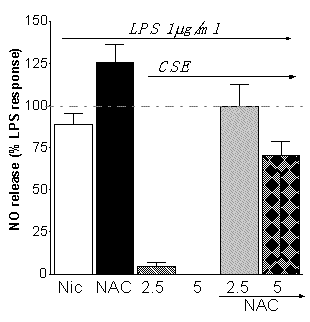| pA2 online © Copyright 2004 The British Pharmacological Society |
051P
University of Bath Summer Meeting July 2004 |
|
Aqueous cigarette smoke extract inhibits macrophage activation by LPS: role of nicotine versus oxidant stress S. K. McMaster, M. Walters and J. A. Mitchell. Cardiothoracic Pharmacology, Unit of Critical Care, The National Heart and Lung Institute, Imperial College, London, SW3 6LY, UK and The William Harvey Research Institute, Barts and the London, London, EC1M 6BQ, UK |
|
Innate immune responses are blunted in smokers which make them susceptible to bacterial colonisation of the lungs, such as occur in COPD (Wedzicha, J et al 2003). We have previously shown that cigarette smoke profoundly inhibits the ability of macrophages to release nitric oxide and express NOSII in response to Gram negative bacteria and to LPS (Fleet et al., 2003). Cigarette Smoke Extract (CSE) is comprised of 6000 different components many of which are toxic and likely to interfere with innate immune response. Recently, nicotine has been shown to inhibit LPS induced release of TNF![]() by human and murine macrophages (Borovikova et al., 2000). However, the effect of nicotine on NOSII activity in macrophages is not known. The oxidant properties of smoke are well documented, however, the role of oxidative stress in smoke induced inhibition of NOSII in macrophages is not known. In the current study we have addressed the potential for nicotine or oxidative stress to be involved in the inhibitory effect of CSE on NOSII activity in murine macrophages.
by human and murine macrophages (Borovikova et al., 2000). However, the effect of nicotine on NOSII activity in macrophages is not known. The oxidant properties of smoke are well documented, however, the role of oxidative stress in smoke induced inhibition of NOSII in macrophages is not known. In the current study we have addressed the potential for nicotine or oxidative stress to be involved in the inhibitory effect of CSE on NOSII activity in murine macrophages.
J774 macrophages were plated at 100,000/well in 96-well plates in DMEM containing 10% foetal calf serum. Cells were left to adhere for 3-6 hours before the addition of nicotine (10-5M) or N-acetylcystine (10-3M). After 30 minutes cells were treated with LPS (1 µg/ml), in some cells CSE (2.5 or 5%) was added prepared according to Walters et al., (2003). Briefly CSE (100%) was made by bubbling mainstream cigarette smoke from 4 Marlboro cigarettes into 100mls DMEM. This was then filter sterilised and diluted with non-smoked medium to the desired concentration. Cells were incubated at 37 OC in an atmosphere of 5% CO2 95% air for 24h hours. Nitrite was then measured using the Griess reaction as an indicator of NOSII activity.

Figure 1; Effects of nicotine (Nic, 10-5M), N-acetylcysteine (NAC, 10-3M) or cigarette smoke extract (CSE; 2.5 or 5%) in the presence or absence of NAC on NO release by J774 macrophages treated with LPS (1 mg/ml). Data is the mean ± S.E.M. for n=9 experiments from 3 experimental days.
Nicotine (10-7 to 10-5M; 10-5M shown, Figure 1) had no effect on LPS-induced nitrite release. NAC
(10 -3M) induced a small increase in LPS induced nitrite release. CSE at 2.5 or 5 % greatly reduced/abolished LPS-induced nitrite release. The effect of CSE on nitrite release was prevented by pre-treatment with NAC. The findings that nicotine, even at high concentrations, had little effect on NOSII activity rules it out as involved in the CSE-induced effects reported here. However, the inhibitory effects of CSE on NOSII in our system appear to be mediated by oxidant stress.
Fleet, MR et al., (2003) Br. J. Pharmacol., 2003; 4P; vol 140
Borovikova, V et al., (2000). Nature, 405; 458-461
Walters M.J, et al (2003) Brit. J. Pharmcol ,138, 44P